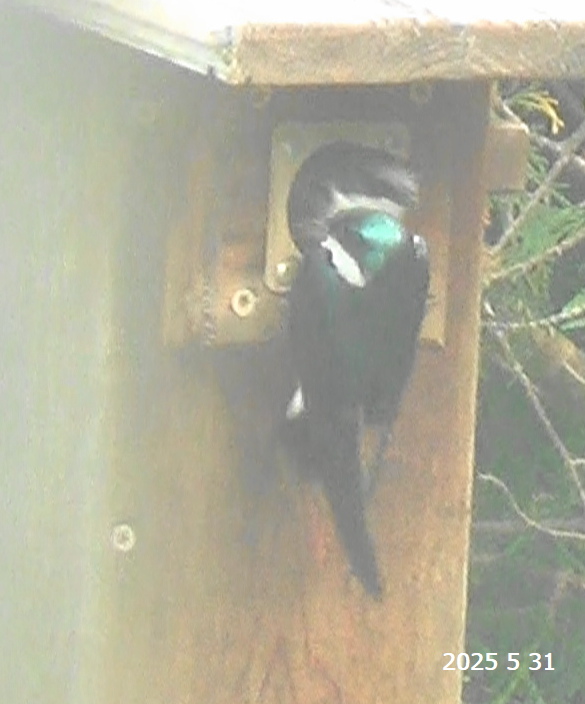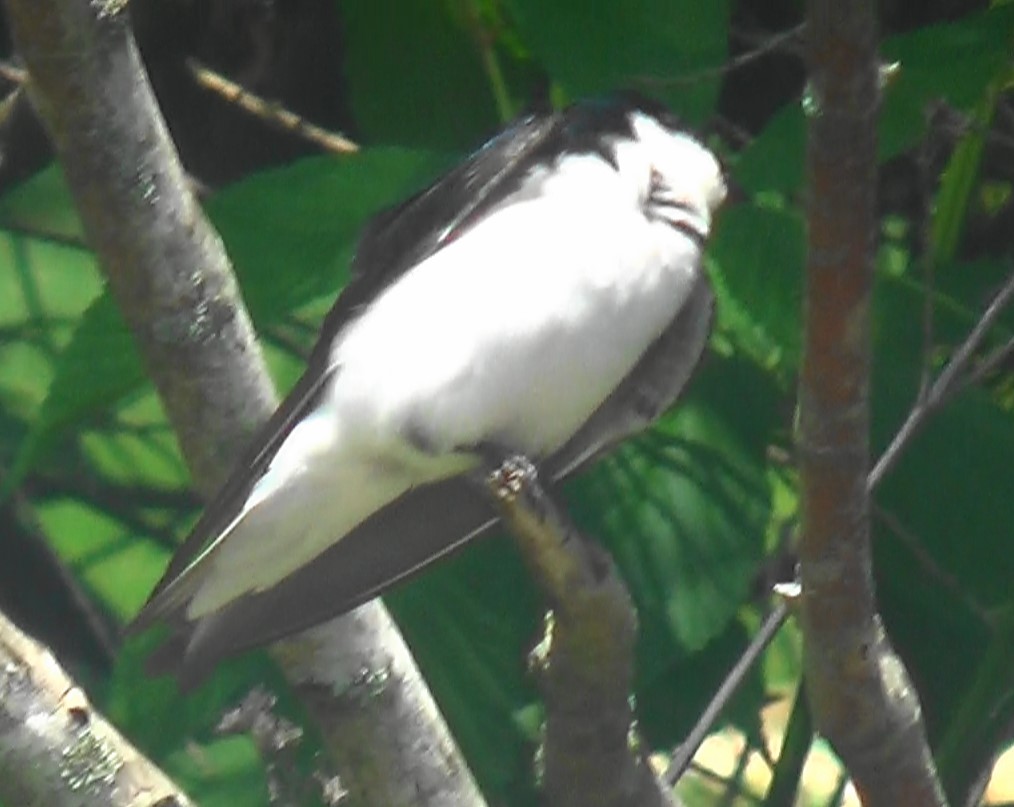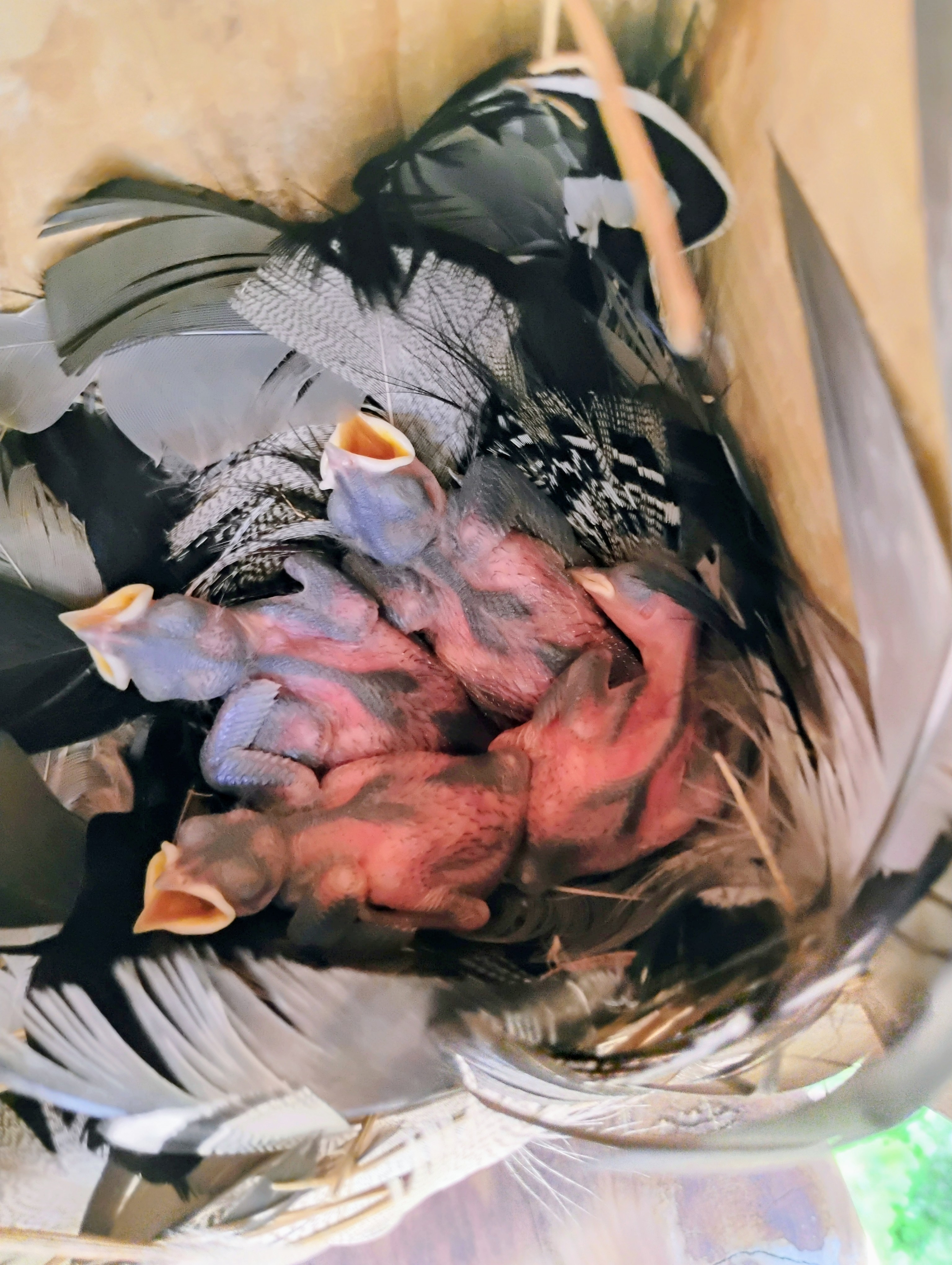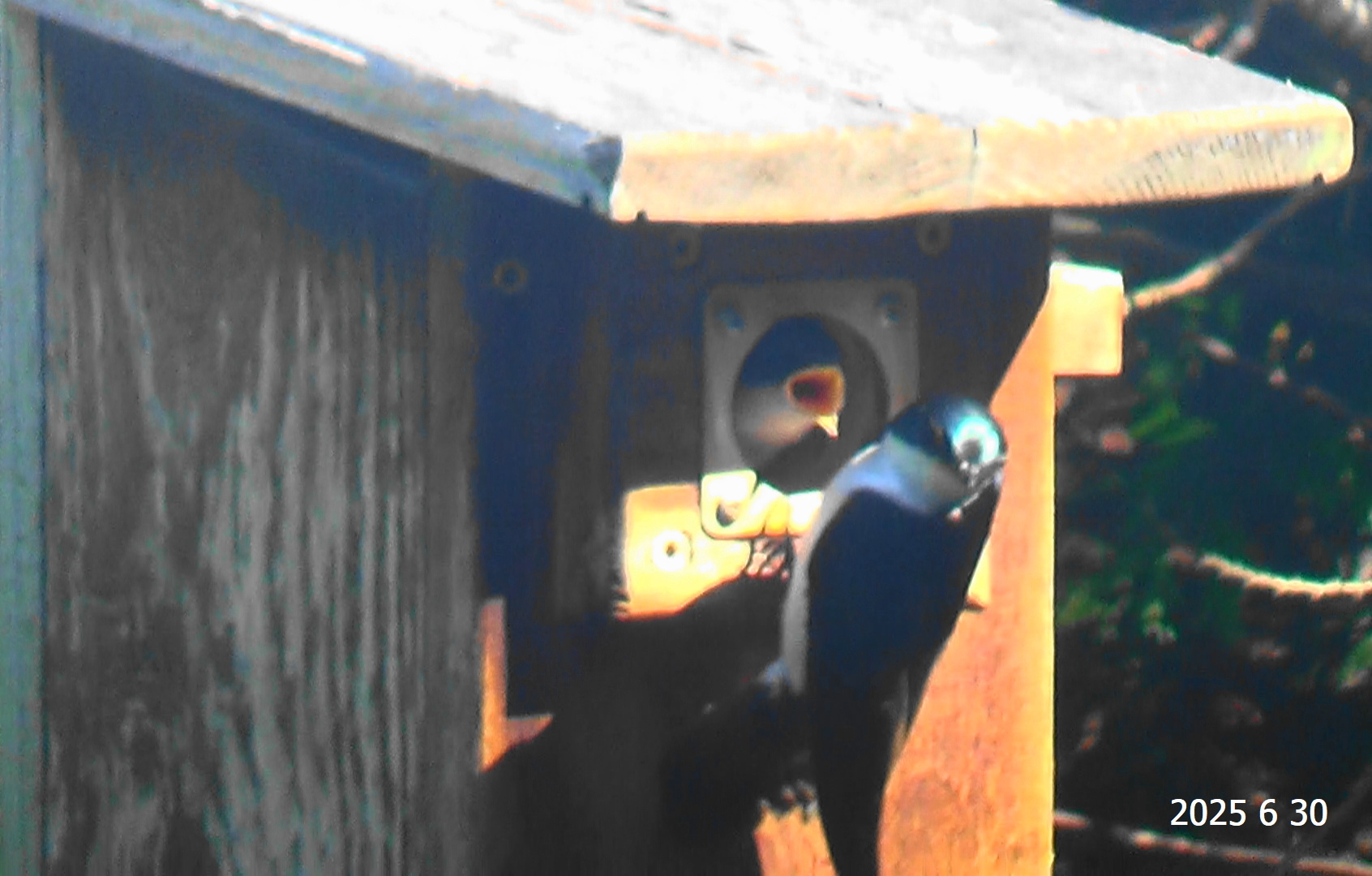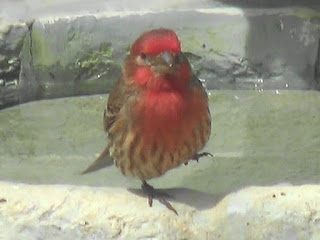Environmental Health
Wednesday, September 10, 2025
Restless Wings: A Glimpse from Whigg Meadow
Wednesday, August 27, 2025
The Eighteen Boxes of Spring
Picture this: 18 tidy little wooden clubhouses lining the fairways of Kahite Golf Course. No membership fees, no POA drama - just prime spring real estate for our feathered pros.
In spring 2025, they stood like empty tee boxes at sunrise, waiting for the season’s first daring players to take a swing.
Before the greens even shrugged off their frosty blankets, local bluebirds - decked out in electric blue and orange - stormed the fairways. Their message was clear: “This course is ours.” Box #13 was snapped up first, followed by #9, #8, and others, as if they were playing a precise round of golf guided by some invisible caddie.
Meanwhile, a single early traveler swallow zipped in like a high-speed golf cart on a downhill slope, claiming Box #14 before the bluebirds could even say, “Fore!” He strutted on top like a club champion, singing his heart out for a mate… and sang… and sang. Sadly, no partner arrived in time. When he finally fell silent, his song became part of the box’s foundation, and Box 14 would later host six swallow and four bluebird fledglings - a bittersweet birdie.
By mid-April, bluebird boxes were filling faster than the clubhouse on dollar beer night. Some couples went bold - like the Box #13 pair, laying seven eggs early. Only four hatched, but all fledged. Par for the course. Box #9 played it safe: four eggs, four fledged. A clean sweep.
Tree swallows, the daredevils of the fairway, weren’t so lucky. Box #3 became a snake snack bar overnight, hatchlings lost before they could take their first flight. Lesson learned: No matter how fearless your dive, predators play through.
Box #5 should’ve been prime real estate - great view, perfect tee shot from the par 3. Instead, it turned into a snake’s practice green. Noel guards weren’t enough, so the grounds crew (ahem, bird team) upgraded to a full baffle system. No takers after that incident. Maybe next year.
Boxes #3, #4, and #5 were all declared “Snake Country,” now armed with more hardware than a pro golfer’s bag. Even swallows in #17 and #18 were targeted, while bluebirds largely defended their turf.
What about the Club Champions and Course Favorites?
Box 8, 13, and 7 are your undisputed champions—perfect rounds, no missed shots, no lost eggs. These boxes are the Augusta greens of the bird world, where bluebirds reign like seasoned pros.
For years, bluebirds have owned boxes #2, #7, #8, #11, #13, and #15. Swallows don’t even step up to the tee here; those bright blue feathers hold the deed.
Box 14? That’s the Swallow Sanctuary, their home course, claimed season after season. The bluebirds don’t even tee it up early but may step up to the box later in the season if conditions play in their favor.
And Box 1 leans swallow, too. Here, the swallows consistently outdrive their bluebird rivals, turning this box into their own clubhouse corner.
The season ended with a flourish at Box #15. On August 24, a proud bluebird mom stood on the Noel guard, insect in beak, calling encouragement to her last chick. She didn’t deliver dinner - oh no, this was a pep talk. Like a golf coach whispering, “You’ve got this, kid,” she coaxed her fledgling to take flight.
By dawn on August 25, the box was empty, fledglings in the trees, season complete. Scorecard signed.
The Kahite Nest Box Open was a mix of triumphs, heartbreaks, and lessons learned. Swallows brought speed and flair but took the brunt of predator attacks. Bluebirds played a steady game, claiming early boxes and defending them with gusto. Snake hazards forced hardware upgrades, and one brave swallow’s sacrifice paved the way for new life in Box #14.
Golfers walked the fairways, some unaware that alongside them played an avian tournament: drives, approaches, birdies (literally), and the occasional bogey courtesy of a black snake. Others knew better. To them, the course wasn’t just manicured grass and well-placed hazards; it was a living stage where tiny dramas played out in nest boxes, each hole a story of courage, heartbreak, and triumph in miniature.
Next spring, the Nest Boxes will open to new tenants again. The tees reset. Who will claim the course next year? Place your bets - this tournament is far from over.
Tuesday, July 1, 2025
Keeper and Leaf
In March, when the air was just beginning to warm and the trees had not yet forgotten winter, the first swallows arrived - gliding in over the glassy waters of Tellico Lake, their wings slicing through cold wind and sky. These early travelers came from the warm edges of the continent - Florida marshes, the Gulf Coast, and the far inland skies of Mexico - pausing to rest, feed, and gather over water, where insects had begun to stir.
But Keeper and Leaf were not among them.
They came later, in April, when the hills around the lake had turned a soft, full green. The irises stood on the edge of blooming. The tall oaks and poplars still held their buds tight, waiting for one more cue of warmth.
The pair arrived quietly, circling low over a cluster of birdboxes—tucked not in open roadside fields like those claimed early by bluebirds, but hidden behind the houses or along the woodland edge, where moss crept between roots and the light filtered softly through.
Had Keeper nested here last year, reclaiming a familiar site? He chose the box at the edge of what used to be a maple - now bare and stark but still sturdy and strong, holding firm against time. This was Maple Nest Retreat, and though the tree that named it had lost its leaves forever, it stood tall, offering its arms.
He chose the box. She chose him.
Keeper, swift and attentive, seemed a wing-length behind his companion. He was watching, guarding, holding the rhythm of the flight. His gentle mate, graceful and intentional in every motion, was Leaf, though her name had not yet been spoken aloud.
Keeper and Leaf were circling low above the quiet yard as if listening for a whisper from the land. For a few days, they came and went. Keeper watched. Leaf explored. Then, with a flit and a flick of her wings, she chose it. And Keeper stood watch as the work began.
Together, they brought threads of life back to the wooden hollow. Bit by bit, they wove it: dried grasses, soft twigs, whispers of the field. But something was missing - something tender, something that would say this nest is home. And so, watching from below, a silent helper brought a few small white feathers near the roots - soft plumes of dawn, taken from a couch pillow and placed gently in offering.
Leaf accepted them. She lifted each feather carefully in her beak, carried them into the nest, and tucked them with elegant care. They curled softly within, forming little clouds of comfort. And then, unexpectedly, she brought a single dry leaf—a peculiar choice for a swallow. Was it meant as a cover for future eggs, or simply a quiet signature of her name? No one could say.
Then came the stillness. A pause. As if the world held its breath. Storms rolled in - thunder that shook the ground, rain that carved rivers in the dirt. But the nest held firm. And one evening, between lightning and the hush of falling rain, the watcher saw them again.
There they sat - Keeper and Leaf, side by side on a bare maple branch, close to the nest they'd crafted.
Not flying. Not building. Just being. A silhouette of devotion against the grey.
It was only the beginning, but it was already filled with sky.
Then they disappeared once more. But the silent observer found three little white eggs nestled safely in the box.
On the evening of May 4, just before sunset, Leaf returned and stayed through the night, Keeper watching quietly from a nearby branch, a sentinel at dusk.
Days passed quietly.
May 8 brought heat—an unexpected swelter—and a quick check revealed five little eggs, resting like pearls among the straw.
Then came chaos.
On that same day, May 8, as the heat rose sharply, a violent storm tore through the valley with hail and fierce winds. On May 10, the ground itself shifted—a magnitude 4.1 earthquake struck just thirteen miles away. The weather turned wild and restless: sudden cold snaps, tornado watches, winds that whistled through the hills like warnings. Yet Keeper remained—vigilant and resolute. Leaf, though brave, seemed shaken. Was she fleeing the box when thunder rolled too close?
Still, the nest held firm.
On May 23, the pair was seen again on the bare maple limbs. Something was stirring. The time felt near.
At the hottest hour of the afternoon, while both swallows vanished briefly into the sky, the observer peered into the box.
Still five eggs.
Still waiting.
And yet—the nest was breathtaking. Leaf, the quiet artisan, had lined it with elegance. Somewhere, somehow, Leaf had found striped black-and-white feathers, likely from a passing Black-and-white Warbler. She had woven them in, giving the nest a quiet elegance. A design of instinct and beauty.
Her taste was refined, even in the smallest touches. But had she lingered too long chasing these treasures, leaving the eggs vulnerable to cold or chaos?
May 24 brought renewed urgency. Keeper, alert and purposeful, darted between sky and nest carrying insects—not yet for hatchlings, but for Leaf, who had begun to stay put. Her patience grew. Keeper tended to her now, slipping food into the box, keeping her nourished as she sheltered their shared future.
Then came the surprise.
By May 28, the clutch had grown—eight eggs now nestled in the downy cradle, a symphony of feathers and hope. Leaf’s artistry flourished, adding iridescent blues and bold Tree Swallow plumes, each one like a stitched promise in her soft architecture.
June arrived heavy and hot. On the second day, the temperature climbed to 82°F—nothing extreme, but the swallows panted, visibly strained. Keeper gaped for breath on a high perch. Leaf mirrored his anxiety, leaving and returning, unsettled. It wasn’t just the heat—something deeper stirred. They were close now. Their movements sharpened, purposeful. Yet tension ran through each wingbeat.
On June 3, five original eggs were missing.
Had they been lost? Buried deep in feathers? Leaf, startled by a soft sound, fled the nest in alarm, hastily covering her newly layed four eggs with trembling care. Her feathers fluffed, eyes half-closed, she seemed worn by the weight of wanting to experience the motherhood. But she stayed.
They both stayed.
Keeper took the lead when needed—offering food, rotating eggs, watching from the maple’s bones. Leaf no longer fled during storms. She had changed. They had changed. Together they learned how to endure.
June 14 crackled with anticipation. Keeper entered the box often now. Leaf circled above, calling, fluttering - restless. Something was coming.
And then, joy.
On June 16, during a brief lull in the skyward traffic, the observer saw them: four tiny hatchlings, barely visible amid the feathers. Three raised their heads in silent hunger, one still and dreaming. They had arrived. On Father's Day, June 15, Keeper had become a father. A fitting gift for a guardian so devoted.
The days that followed were a blur of motion—endless flights for food, careful cleaning of the nest, quiet songs in the dusk. They were tireless. They were whole.
But the trials were not done.
The days grew longer. The sun climbed higher.
As the summer solstice passed - when the sun shone most directly on this little corner of the world - the heat returned with vengeance. A high-pressure ridge scorched the land. Temperatures surged into the mid-90s. With dew points in the 70s, the heat index soared above 105°F. Heat advisories blanketed the region. The air shimmered. The nest box baked like an oven.
Still, they stayed.
Keeper and Leaf took turns shielding their chicks from within, wings spread slightly. Watching, ventilating and protecting. They didn’t leave the nest unguarded for more than a minute. Every return brought food, and every visit was a promise: we are here.
On June 24, a milestone: one brave chick appeared at the nest entrance. Just 9 days old, too young to fledge, but strong, alert, and eager for food. The parents fed him tirelessly. The others stayed hidden. Were they safe? Healthy? It was hard to tell. But each day, a small face returned to the entrance, wide-eyed and waiting.
Please, the silent observer thought, just don’t jump - not yet.
A quiet worry lingered: was it always the same chick? Were the others simply more cautious, or struggling silently beneath the feathers?
Then came the morning of July 1.
At 7:30 AM, one chick lay sleeping peacefully near the entrance. The observer stepped out for a morning run - quietly, carefully, far from the nest.
And then, from the corner of the yard, three swallows lifted into the sky.
One. Two. Then three.
They circled low over the house - quick, purposeful, and knowing. It felt like a farewell. And then, without hesitation, they turned southeast—toward the lake.
The nest was empty.
Inside: a few beetle wings, a wisp of down. No broken shells. No unhatched eggs. Just a smooth, worn hollow - the final signature of a story completed.
Their panting in June, their restless movements - it all made sense now.
A double clutch. Nine eggs. Five gently removed. Four healthy fledglings. Gone by Day 17—soaring early, strong, and whole. A triumph.
And something else had gone, too.
The dry leaf - Leaf’s quiet signature, once nestled at the center - had vanished. Perhaps carried out with the unhatched eggs. A soft symbol of inexperience shed, of the transformation she'd undergone. Of who she had become.
They’ll linger now near the lake, where the air is rich with insects and the open skies offer safe space to practice their flight. In just a few weeks, the swallows will gather with their young - rising in swirling flocks above golden fields and glassy water, tracing invisible paths southward. Back to the marshes and coasts. Back to rest.
The yard is quiet now. Still. Not lonely - just changed.
Because they were here.
Because they will return.
Because the bare maple branch - old, gnarled, once thought lifeless - has sprouted something new.
A single shoot.
A young branch with tender, red maple leaves.
REFERENCES
https://nestwatch.org/explore-data/nestwatch-open-dataset-downloads/
The evidence from recent years shows that birds are nesting weeks earlier than they used to and this spring may be no exception.
https://phys.org/news/2024-03-early-earlier-birds.html
Thursday, June 12, 2025
On Compost and Plastic Benches
Dear Earth Diary,
It’s me again. Your average suburban eco-guilt-ridden citizen clinging to my compost bin like it’s a life raft in the climate apocalypse. Armed with seven reusable grocery bags, an emotional support bamboo toothbrush, and the steadfast belief that if I just recycle hard enough, the polar bears will survive.
A new study in PNAS Nexus tells that skipping one transatlantic flight, eating less meat, or not getting a dog (no offense, Max) makes a vastly larger dent in emissions than a lifetime of sorting cans and switching to LED bulbs.
Most of us overrate the impact of what we’re doing—recycling, driving a hybrid, refusing straws like eco-warriors at a paper-plastic battlefield—while ignoring the big-ticket stuff that actually matters: flying less and biking more.
Worse, these micro-actions—if we think they’re enough—can actually reduce our willingness to support collective solutions. It’s the environmental version of "I donated once, I’m good." Except the donation was a rinsed yogurt container, and the house is still on fire.
Remember the Municipal Food Scrap Initiative? Aka, “Put all your rotting leftovers in this biodegradable, city-approved bag that disintegrates on contact with oxygen, feelings, or the faint idea of humidity.”
It felt good—for about three weeks. The smell? Biblical. The pests? Legendary. The results? Predictable. Most of the food scraps still ended up in the landfill because the sorting center was “overwhelmed by enthusiasm and spaghetti.” Apparently, banana peels and shredded bills were clogging the machinery. And someone—probably Gerald from Apartment 3B—kept tossing in metal forks like he was trying to short-circuit the revolution.
Early programs relied heavily on voluntary participation, which mostly translated to “optional until it smells bad.” Without clear mandates or penalties, enthusiasm wilted faster than last week’s cilantro. Now California’s cracking down: SB 1383 says by 2025, 20% of edible food waste must be recovered to feed people, not landfills. Jurisdictions must build food recovery programs, donors have to get their act together, and tossing perfectly edible leftovers could soon come with a fine.
Will these mandates finally shift behavior—or just make the compostable bag industry even richer? Jury’s still out.
Meanwhile, the regular recycling bins remain a full-blown theater of chaos. I separate plastics like a forensic analyst, rinse jars like I’m prepping for surgery, and arrange cardboard with the devotion of a monk folding sacred texts. And then?
The garbage truck arrives, and with one magnificent whoosh, everything—plastics, papers, dreams—goes into the same compartment. I swear I heard the bottles scream.
But don’t worry. We’re told that plastic lids can be used to make benches. Benches! Thousands of them! Just... don’t ask where they are. Or how many lids it takes to make one. Or whether they even exist. Maybe they’re part of a Google moonshot—vague, glossy, heavily branded, and possibly mythical.
Speaking of Google: what are those moonshot projects doing? Solar kites? Smart lenses for goats? AI for sorting good vibes from bad ones? Every time I click on a press release, it’s like opening a fortune cookie that says, “We're very innovative. Don’t ask questions.”
In the meantime, I carry seven reusable bags, refuse straws like it’s a personal crusade, and have developed mild carpal tunnel from peeling stickers off fruit so they don’t contaminate the compost. Which, ironically, no longer exists.
But hey, at least I feel morally superior while watching a garbage truck hurl everything—recyclables, organics, my hope—into the same yawning void.
So if you're out there, Real Sustainability: Please stand up. Bring receipts. And maybe a bench. I could use the rest.
Tuesday, May 13, 2025
Mr. and Mrs. Pi
We first met Mr. and Mrs. Pi on a crisp morning in March, the 14th of 2020. The air was in the low 50s (°F), and the patio was quiet save for the faint rustling of early spring. That’s when we saw them — two house finches busily at work beneath our retractable roof, weaving the foundations of a home in the corner nook of the patio.
Mr. Pi, caught red-beaked in the act, dropped a straw when he noticed me. He looked so startled — almost embarrassed — but endearingly so. Within days, they realized we meant no harm. The nest was completed with astonishing speed. Eggs were laid. Life quietly stirred. Then one day, wild little chicks emerged.
And one unforgettable moment - on April 18 - I captured a photo of a brave young finch flying the coop. He landed on the patio railing, looking around with wide eyes — wonderstruck. The world was big. So much to explore. And just like that, he took off into the yard — into life.As one brood fledged and fluttered off into the world, Mrs. Pi had already begun constructing the next nest. Mr. Pi, dutiful and proud, guided the young — now feathered and restless — on their first hops and flights. Another brood came, and then another.
As the season warmed, the Pi family shifted their nest to the opposite corner of the patio, perhaps sensing the subtle change in heat and light. I began calling it Pi Palace — their elegant little haven — when reporting to Cornell’s NestWatch.
That summer of 2020, I caught many glimpses and treasured moments:
— a radiant Mr. Pi on April 22, perched triumphantly atop our water fountain.
— Mr. Pi enjoying the yard, chest puffed and wings alert on May 31
— a tiny chick sleeping peacefully in the nest on July 29, his head barely fluffed, looking almost prehistoric when zoomed in — a little dinosaur in down.
Seasons passed. The retractable awning was eventually replaced with a beautiful pergola topped by a transparent roof. The original nesting corner was no longer usable, but the Pi family, ever resourceful, simply shifted to the remaining corner. They stayed, singing songs from our ledges.
Each fall, I would gently clean out the nests. But not in 2024. In early 2025, I noticed an old nest hanging low. Had a raccoon pulled at it? Or had the finches themselves dismantled it to make way for the new?
I left it untouched - their domain.
Then came May 8, 2025 — a fierce storm swept through with high winds and hail. Just two days later, on May 10, a magnitude 4.1 earthquake struck, its epicenter only 13 miles away. When I checked the nest on May 11, it was gone — completely blown away.
I found remnants. The fallen nest showed no eggs, just some fecal matter and an old pale blue shell — likely from the previous season. But what stunned me was the new nest I had seen earlier: a true architectural marvel. Unlike the simpler constructions from 2020, this one was built with polypropylene mesh netting — white, lightweight, water-resistant, and incredibly strong. It wasn't just insulation — it formed a structural framework around the cup of the nest. Inside, the lining was soft with fur, carefully chosen for warmth and comfort.
Mr. and Mrs. Pi and their offspring had adapted — not just surviving, but evolving, weaving human-made materials into the fabric of their home. It was a quiet testament to ingenuity and resilience, to learning over time, and to the persistence of life at the edges of our own.
What began with a startled straw-drop in 2020 became five years of quiet companionship — seasons of nests, fledglings, and shared space. Their broods grew, their brilliance shone, and their trust gently deepened.
And if you're still nearby, the original Mr. and Mrs. Pi — thank you for making our patio your home, the Pi Palace. Whether it’s you or your descendants fluttering through the garden now, your legacy lives on. In your small, determined way, you showed us how life adapts, how beauty is built from scraps, and how even the tiniest creatures can leave lasting imprints on our hearts.
Friday, August 30, 2024
Sustainable Growth in Planned Communities
In the United States, the burden of disease increasingly involves chronic conditions like obesity, mental health disorders, and cardiovascular diseases—issues closely linked to our built environment. Urban development since the 1950s has drastically reshaped this environment, reducing green spaces, increasing traffic-related air pollution, and limiting opportunities for interaction with nature. These changes have contributed to a decline in public health, marked by rising rates of obesity, stress, and injuries, particularly in densely populated urban areas.
Master-planned communities (MPCs), especially those situated away from urban congestion, offer a healthier and more holistic living environment. Active adult lifestyle communities (AALCs), such as Tellico Village in rural Tennessee, exemplify this trend. These communities provide abundant green spaces, extensive hiking trails developed by retirees, and foster a strong sense of social connection, enhancing physical activity, mental well-being, and opportunities for community engagement. For retirees and those seeking better health outcomes, MPCs like these are increasingly appealing due to their integration of natural surroundings and communal support systems.
Poor living conditions are well-known risk factors for adverse health outcomes, while access to parks, green spaces, and blue spaces like lakes and rivers has been shown to reduce stress and decrease mortality during extreme heat events. Tellico Village’s proximity to a lake, woods and mountains showcases how the combination of green and blue spaces can create an environment that supports healthier living, promoting both physical activity and relaxation.
A recent paper on arXiv explores the growth patterns of MPCs using Tellico Village as a case study, highlighting how predictive modeling can guide sustainable development. As environmental health enters a critical phase, research will increasingly focus on integrating housing growth, microtransit, recreational activities, food services, and preventive health measures into MPCs to support healthier communities. AALCs provide social interaction, physical activity, and engagement opportunities that have been shown to positively influence cognitive function and delay the onset of neurodegenerative conditions. As these communities evolve, they hold potential to become integral to aging-in-place strategies, incorporating advancements in healthcare, smart home technologies, and brain health interventions.
Looking ahead, the planning and development of age-restricted communities must address the complex dynamics of aging populations. Advanced forecasting techniques, such as the Time-Varying Markov Models (TVMM) developed by Allsup and Gabashvili (2024), offer innovative approaches to anticipating the needs of these communities, particularly during transitions between growth phases. This method helps navigate the complexities of MPC development, ensuring that Active Adult Lifestyle Communities remain vibrant and supportive environments for older adults.
The study by Allsup and Gabashvili marks a significant advancement in understanding MPC growth dynamics. By focusing on micro-level interactions and decision-making, the research introduces a data-driven approach that reflects the real-world behaviors within these communities. This granular perspective enriches our understanding of MPC development and enhances the precision of future forecasting models, guiding strategic planning.
Moreover, this study is groundbreaking in its use of extensive data from state and local MPC authorities, setting a precedent for future research and planning. As age-restricted communities continue to evolve, these insights underscore the potential for integrating healthcare advancements, smart technologies, and targeted brain health interventions, positioning MPCs at the forefront of aging-in-place strategies.
This juncture represents a transformative moment in reimagining how we design living spaces that prioritize health, sustainability, and well-being, paving the way for communities that enhance the quality of life for older adults in a rapidly changing world.
REFERENCE
Allsup C.K., Gabashvili I.S. Modeling the Dynamics of Growth in Master-Planned Communities August, 2024 arXiv:2408.14214 [econ.EM] https://doi.org/10.48550/arXiv.2408.14214
Sunday, June 9, 2024
Life Exposures and Health
In our daily lives, we are exposed to thousands of substances, yet the impact of many of these chemicals on our health remains unclear. This gap in knowledge is what the Southern Environmental Health Study (SEHS) aims to address. By finding connections between life exposures and health, this study seeks to improve the well-being of all communities. Adults between the ages of 40 and 70 who live in southern states are invited to join this critical research effort. Compensation is provided for participation.
The SEHS is enlisting volunteers to wear specialized wristbands for seven days. These wristbands, designed to absorb a variety of chemicals, provide insight into the substances individuals encounter in their environment and those emanating from their bodies. By participating, you will help to map out the spectrum of chemical exposure over a week, offering a unique window into the interactions with our surroundings.
The wristbands used in this study are equipped with advanced materials capable of absorbing a wide range of chemicals, including:
Polycyclic Aromatic Hydrocarbons (PAHs)
Organophosphate Esters (OPEs)
Pesticides
Plasticizers including Phthalates
Flame Retardants (FRs)
Polychlorinated Biphenyls (PCBs) and Brominated Flame Retardants (BFRs), including PBDEs (Polybrominated diphenyl ethers)
Nicotine and Cotinine
Phenols
VOCs including Carboxylic Acids, Alcohols, Ketones, Sulfur- and Nitrogen-containing compounds
The wristbands operate through a process known as solid-phase microextraction (SPME), where the material absorbs chemicals directly from the environment and from sweat. These absorbed chemicals are then analyzed using Gas Chromatography-Mass Spectrometry (GC-MS), allowing for the identification and quantification of a wide range of compounds.
Traditional wristbands can accumulate a wide range of volatile organic compounds (VOCs), but not all materials have a high affinity for molecules like trimethylamine (TMA). TMA is more difficult to be captured due to their high polarity and poor extraction efficiency. One approach to capture these molecules is solid-phase microextraction (SPME), which couples with triple quadrupole gas chromatography tandem mass spectrometry. Previous research on SPME of SCFAs demonstrated poor extraction efficiency, necessitating on-fiber derivatization to enhance detection sensitivity. To improve the capture of molecules like TMA, pre-coating the wristband material with reagents that react with TMA to convert it into a less polar and more easily extractable compound could be employed. Common reagents include pentafluorobenzaldehyde (PFB) or o-phthalaldehyde (OPA). Using materials like ion-exchange resins or functionalized polymers with a high affinity for polar compounds or higher surface area for adsorption would also help. Even with traditional materials, optimized solvent extraction or multi-step extraction processes could improve capture efficiency.
For this study you will be asked to wear a wristband. In the past, participants also wore samplers on their ankles, chest, and shoes. Shoe samplers were more sensitive to particle-bound semi volatile compounds (SVOCs), while chest samplers collected more exhaled compounds. Many chemicals displayed seasonal fluctuations.
The longer the wristband is worn, the more chemicals accumulate on it. The wristbands absorb chemicals at a rate proportional to the environmental concentration of these chemicals over time, effectively sampling the environment in a first-order kinetic manner.
To join, click this link.
Eligibility: Adults ages 40-70 living in Alabama, Arkansas, Delaware, District of Columbia, Florida, Georgia, Kentucky, Louisiana, Maryland, Mississippi, Missouri, North Carolina, Oklahoma, South Carolina, Tennessee, Texas, Virginia, West Virginia.
REFERENCES
Fuentes ZC, Schwartz YL, Robuck AR, Walker DI. Operationalizing the Exposome Using Passive Silicone Samplers. Curr Pollut Rep. 2022;8(1):1-29. doi: 10.1007/s40726-021-00211-6. Epub 2022 Jan 4. PMID: 35004129; PMCID: PMC8724229.
Roodt AP, Naudé Y, Stoltz A, Rohwer E. Human skin volatiles: Passive sampling and GC × GC-ToFMS analysis as a tool to investigate the skin microbiome and interactions with anthropophilic mosquito disease vectors. J Chromatogr B Analyt Technol Biomed Life Sci. 2018 Oct 15;1097-1098:83-93. doi: 10.1016/j.jchromb.2018.09.002. Epub 2018 Sep 3. PMID: 30212730



